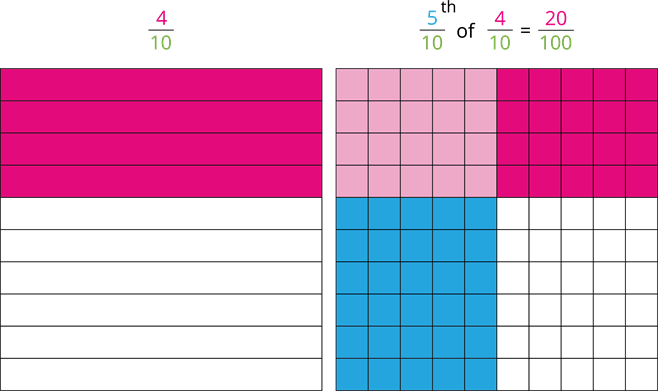
PUMPA - SMART LEARNING
எங்கள் ஆசிரியர்களுடன் 1-ஆன்-1 ஆலோசனை நேரத்தைப் பெறுங்கள். டாப்பர் ஆவதற்கு நாங்கள் பயிற்சி அளிப்போம்
Book Free DemoKavitha wants to buy biscuits that cost ₹20.5. If she needs 5 biscuits, how much she should pay?
We can simply answer it, by multiplying the cost and the number of biscuits. we get 20.5 × 5 = 102.5.
In many situations in our daily life, we use the multiplication of decimal numbers. We shall explore it in the upcoming lessons.
Here we split the decimal multiplication into two parts as follows.
i) Decimal multiplication through models and area models.
ii) Multiplication of Decimal Numbers by 10, 100 and 1000.
Decimal multiplication through models and area models.
Now let us find the 0.1 × 0.1 using the grid model.
We can rewrite 0.1 as ; Therefore, 0.1 × 0.1 = : That is ^t^h of .

Shade the horizontal area of by red color. And shade blue color on the vertical area of .
^t^h of is the common portion, which is ^t^h.
Therefore, it shows that = = 0.01.
Hence, 0.1 × 0.1 = 0.01.
Now by applying the above concept we see an example with some other numbers.
Example:
Find 0.5 × 0.4
- Let us first shade 4 rows of the grid in red colour to represent 0.4.
- Shade 5 columns of the grid in blue colour to represent 0.5 of 0.4.
- Now 20 squares represents the common portion.
- This represents 20 hundredth or 0.20. Hence 0.5 × 0.4 = 0.20.

In the above figure, we can observe that the number of decimal digits in 0.20 is two. So, we can conclude that the number of decimal digits in the product of two decimal numbers is equal to the sum of decimal digits which are multiplied.